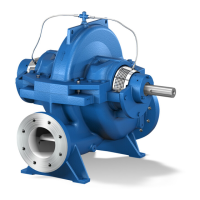29
Operating maual mechanical seal
Rev. 0, 13.02.2004
H Multiple springs in guide sleeves
H axial mobility/play up to dw 55 = ± 2 mm, an d ± 3mm
H Torque transmission by grub screws
H Connecting dimensions to DIN 24960 KB
H Installation dimensions l
1K
J LIQUID SUPPLY TO MECHANICAL
SEAL
To ensure trouble--free operation of the mechanical seal, a sui-
table circulation process has been selected on the pump, see
section 9 of the pump’s operating manual. This process avoids
product deposits in the seal chamber.
J EMISSIONS
Mechanical seals are dynamic seals which for physical and
technical reasons cannot be completely leak --free. The amount
of leakage largely depends on the seal selection, production to-
lerances, operating conditions, smooth running of the machine,
etc. Compared with other dynamic sealing systems, however,
mechanical seals have little leakage.
Leakage may be liquid or gaseous, its aggressiveness corres-
ponding to that of the fluid to be sealed off.
Any mechanical seal leakage must be drained offin a controlled
way and safely disposed of.
. Components which may come into contact with the seal lea-
kage shall either be corrosion resistant or must be adequately
protected.
J STORAGE
Unless otherwise agreed in the contract, mechanical seals are
delivered in standard packaging suitable for dry transport by
truck, train or plane. The symbols or handling instructions given
on the packaging must be adhered to.
For incoming goods
inspection:
D Check packaging for external damage.
D Carefully open packaging, making sure not to damage or
lose any components packed separately.
D Check c onsignment for completeness (deliv ery note). The
supplier shall be notified immediately of any damaged
goods or missing parts.
The instructions given below shall apply both to mechanical
seals delivered and stored in their undamaged, original packa-
ging, and to mechanical seals already installed in a pump,
which have not been in operation yet.
The mechanical seals need not be preserved.
D Do not apply anti--corrosives.
' Risk of deposits and possibly chemical attack of the ela-
stomer secondary sealing elements.
When applying preservatives to entire systems where mecha-
nical seals are installed please check the following:
D Verify the compatibility of the preservatives chosen with the
materials of construction and the elastomer components of
the mechanical seal.
D Verify that mechanical seal movementis not restricted by re-
sin deposits or sticking.
During storage, seal face materials and elastomers will un-
dergo material specific time dependent changes (distortion,
ageing), which can impair the perfect function of the mechanical
seal. The specified storage period must therefore be complied
with.
The manufacturer cannot be held responsible for damage re-
sulting from improper storage.
The room where mechanical seals are kept must be dust--free
and moderately ventilated, with an even temperature. We re-
commend: relative humidity below 65%, temperature between
15 °C and 25 °C.
The mechanical seal shall be protected from:
D direct heat from sun, heating
D ozone and ultraviolet light from halogen lamps, fluorescent
lamps, sunlight, arc welding
' danger of embrittlement of elastomer materials.
The seals shall be stored in their original packaging on a level
surface.
The mechanical seal needs to be checked:
D after a storage period of approx. 2--3 years
D if the packaging has been damaged
D after a shock load (e.g. if the mechanical seal package has
been dropped)
' at the manufacturer’s workshop or nearest service centre.
J BEFORE INSTALLATION
Checks to be carried out on the pump components:
Shaft surface in the area of the dynamically loaded seal ring:
roughness depth Rmax 5 mm.
Checks to be carried out on the
pump:
D Check c ontact surfaces between the pump and the mecha-
nical seal for damage.
D Connecting dimensions, squareness and concentricity to
shaft
D Shaft run --out as per DIN ISO 5199: between 50 mm and
100 mm, depending on the diameter.
D Apply a thin coat of a suitable grease to the shaft in the
mech. seal area.
' Never use mineral oil base lubricants on sealing elements
made of ethylene propylene rubber (swelling, possibly de-
composition).
' Grease recommended for elastomer sealing elements
(O--rings, e tc.): type ”TURMOPOLGREASE SH2”, produ-
cer: Lubricant Consult (LUBCON).
' Double PTFE encapsulated O--rings must be fitted so that
the joint of the outer sheath points in opposite direction to
the mounting direction, so that the friction force generated
when sliding on the O--ring closes the joint. Kinks in the foil
will result in leakage.
J INSTALLATION TOOLS / EQUIPMENT
D Propyl alcohol + paper tissue (no cleaning rags)
D
lubricant for elastomer--sealing rings: Type ”TURMOPOL-
GREASE SH2”, make Lubricant Consult (LUBCON)

